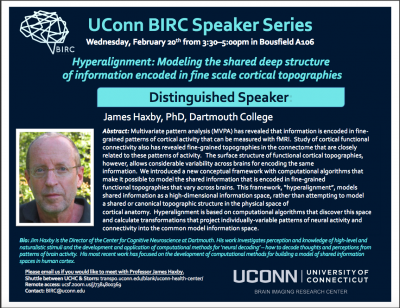Dartmouth College
Distinguished Speaker
Wednesday, February 20 2019 3:30-5:00PM Bousfield A106
Abstract: Multivariate pattern analysis (MVPA) has revealed that information is encoded in finegrained patterns of cortical activity that can be measured with fMRI. Study of cortical functional connectivity also has revealed fine-grained topographies in the connectome that are closely related to these patterns of activity. The surface structure of functional cortical topographies, however, allows considerable variability across brains for encoding the same information. We introduced a new conceptual framework with computational algorithms that make it possible to model the shared information that is encoded in fine-grained functional topographies that vary across brains. This framework, “hyperalignment”, models shared information as a high-dimensional information space, rather than attempting to model a shared or canonical topographic structure in the physical space of cortical anatomy. Hyperalignment is based on computational algorithms that discover this space and calculate transformations that project individually-variable patterns of neural activity and connectivity into the common model information space.
Research Focus: My current research focuses on the development of computational methods for building models of representational spaces. We assume that distributed population responses encode information. Within a cortical field, a broad range of stimuli or cognitive states can be represented as different patterns of response. We use fMRI to measure these patterns of response and multivariate pattern (MVP) analysis to decode their meaning. We are currently developing methods that make it possible to decode an individual’s brain data using MVP classifiers that are based on other subjects’ data. We use a complex, natural stimulus to sample a broad range of brain representational states as a basis for building high-dimensional models of representational spaces within cortical fields. These models are based on response tuning functions that are common across subjects. Initially, we demonstrated the validity of such a model in ventral temporal cortex. We are working on building similar models in other visual areas and in auditory areas. We also plan to investigate representation of social cognition using this same conceptual framework.
Visitors from UCHC are encouraged to use the UCHC-Storrs shuttle service. Talks can also be joined remotely. Please contact us if you are interested in meeting with the speaker.
